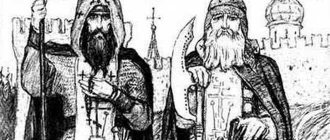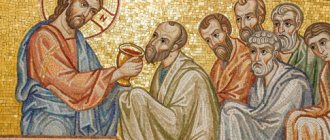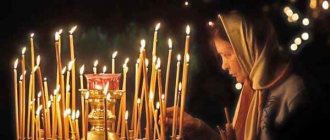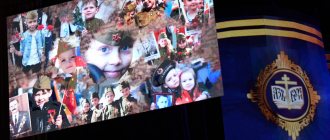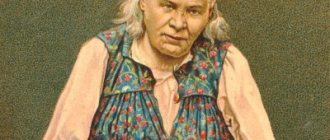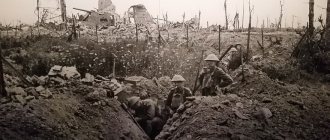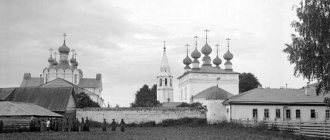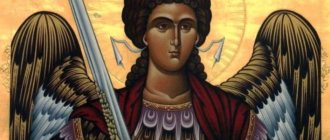The duel between Alexander Peresvet and the invincible Tatar-Mongol warrior Chelubey is one of the mysteries of history.
The duel between Peresvet and Chelubey is often called the battle of the Forces of Light and the Forces of Darkness...
Why is this fight given such importance? And who really were Peresvet and Chelubey ?
It is known that the duel preceded the Battle of Kulikovo Field in 1380.
The Battle of Kulikovo or the Massacre of Mamai is the largest battle in history of the Russian army led by Grand Duke Dmitry Donskoy and the army of the beklarbek and temnik of the Golden Horde Mamai.
The battle took place on September 8, 1380 on the Kulikovo Field, in the area south of the confluence of the Nepryadva River with the Don (southeast of the Tula region).
The Battle of Kulikovo became the decisive battle between Russian troops and the army of the Golden Horde, which had dominated Russian lands for more than a hundred years.
Before the battle on the Kulikovo field, Grand Duke Dmitry Ivanovich went to St. Sergius of Radonezh for a blessing .
The abbot of the Russian land, as St. Sergius was called, not only blessed the prince for the battle, but also predicted a victory that turned the Moscow ruler into a great historical figure - Dmitry Donskoy.
Sergius of Radonezh also sent his warrior monks, Alexander Peresvet and Andrei Oslyabi .
Their presence was supposed to strengthen the prince’s faith and inspire the Russian army.
Biography of Peresvet
Alexander's date of birth is not known for certain. A number of sources indicate a boyar origin. That is, belonging to the upper class. Boyars held leadership positions and owned lands. In the 14th century, every boyar studied military craft from childhood. Place of birth: Bryansk. Presumably, Alexander Peresvet participated in campaigns and wars. At some point he became a monk. The ceremony was held in Rostov. Since there are practically no authoritative sources that could reliably report on certain events, historians are still debating the biography of Peresvet. The problem also lies in the fact that ancient writers often resorted to allegories and exaltations. That is, famous personalities were credited with feats and qualities that they did not actually possess. And it is quite difficult for modern scientists to distinguish fiction from reality.
One way or another, we can safely say that by 1380 Alexander Peresvet was a monastic schema-monk. It was in this rank that he approached the Kulikovo battle, which brought him eternal glory.
Prerequisites
In the 14th century, Rus' was exhausted under the Mongol-Tatar yoke of the Golden Horde. At the same time, the influence of the Muscovite kingdom increased. Several Russian princes were able to win several victories over the Tatars, which gave strength to the resistance to the occupation. In 1376, Russian troops began to liberate their land, pushing the Horde to the south. During the retreat, the Mamai khans ravaged several principalities, but never entered into open battle. In mid-August, the Russian army arrives in Kolomna. Warriors are gathering in different ways from all over Rus' to repel the Tatars once and for all. Horde leader Mamai believes that Dmitry will be afraid to cross the Oka River and hopes for quick help from the Lithuanians. But by the beginning of September, the Russians crossed the river and moved through the Ryazan lands to Mamaia. Among the soldiers was Alexander Peresvet.
Such a maneuver by Dmitry was regarded as a rash step. Panic rumors spread throughout Rus' about the imminent defeat of the coalition of princes.
Battle of Kulikovo
On September 8, the famous Battle of Kulikovo and the duel between Peresvet and Chelubey took place. The day before, Russian troops crossed the Don River. Grand Duke Dmitry gathered from 40 to 60 thousand people under his banners. The Moscow regiment was the core. The arriving Lithuanians and Ryazans stood on the flanks. On the night of September 7, a review of the troops took place. Dmitry understood the enormous responsibility that was entrusted to him. Because in case of defeat, all lands to Moscow would be open to the Tatars. Therefore, the review was carried out very carefully.
Alexander Peresvet was most likely in the central regiment with the court of the Moscow prince. In the dead of night, scouts from both sides inspect enemy positions. Only in the morning do the first skirmishes occur. The Tatars led about 100 thousand people to the Kulikovo Field. Since medieval sources tend to significantly increase the number of troops, it is quite difficult to determine the true number. Some sources indicate up to 40 thousand Russian soldiers and up to 60 thousand Tatars. On the morning of September 8, the Russians formed battle formations. The legendary heroes of the ensuing battle gave speeches. A thick fog spread across the field, and the Russians waited in stupor for several hours for the battle to begin. A few hours later, the Tatars emerged from the forest in a dense wall.
Peresvet in folk and church traditions
The Venerable Martyr Alexander Peresvet is one of the patron saints of Bryansk, and for this reason it is important to present as clearly as possible the history of the veneration of the warrior monk and his brother, because Andrei-Rodion Oslyabya should rightfully be attributed to the same sacred Bryansk squad. In any case, such a prominent expert on ancient Russian archives as S. B. Veselovsky, based on records of local disputes, suggested that “Peresvet and Oslyabya were immigrants from Bryansk.”
It is well known that his contemporaries did not leave any written references to Alexander Peresvet, other than chronicles and poetic stories about the Battle of Kulikovo. In addition, in the Bryansk region, no oral traditions about the monk or historical local names associated with Peresvet have been preserved. The closest locality of this kind to us is the one mentioned for the first time in 1401-1402. “Peresvetov’s purchase” was located not far from Kozelsk. True, Kozelsk in the year of the Battle of Kulikovo was one principality with Karachev, now the regional center of the Bryansk region. And therefore we can assume that Peresvet acquired these “purchases” of his when he was a Bryansk boyar.
Meanwhile, legends about Peresvet exist in the north and northeast of Rus', on the White Sea, as well as in the Rostov and Ryazan lands. There are also relics associated with the name of this Bryansk boyar.
On the so-called Winter Coast of the White Sea, the Russian ethnographer A. Markov recorded at the end of the 19th century an ancient epic with a very rare plot - “The Kama Massacre”. The epic was about the last battle of Russian heroes. In the list of participants in this battle we meet a name that is quite consonant with Peresvet - the hero Peresmeta Stepanovich, or in another version Peremetushka Vasiliev “and with his nephew.” Let us recall that Peresvet’s nephew, Yakov, son of Oslyabi, also took part in the Battle of Kulikovo. Reverend Martyr Alexander Peresvet and his nephew were in the advanced regiment, whose soldiers went on reconnaissance into the wild steppe. One of the editions of “The Tale of the Massacre of Mamayev” describes how Peresvet’s nephew Yakov Oslebyatev captured the Tatar “language” on the eve of the Battle of Kulikovo. Peresmet Stepanovich and his nephew appear in the epic as the same intelligence officers. They are given the order by the commander of the heroic army, Ilya Muromets:
You are a goy, son of Stepanovich of Peresmet! Just go with your and your nephew, Go to the open field, on the okatisty Sholomya (hill), And take a spyglass, And how can you count and count this great power, This great unfaithful power...
In 1885, Rostov local historian A. A. Titov, who worked with loose and fodder books of Borisoglebsky at the Ustye Monastery (18 versts northwest of Rostov the Great), published a legend that Alexander Peresvet took monastic vows in this monastery, founded in 1363 by students of St. Sergius of Radonezh by elders Theodore and Paul. If the legend is true, then it becomes clear why Peresvet entered the battlefield not with the Bryansk squad, but in the advanced regiment. Probably, the boyar did not serve the last generation of Bryansk princes and left his hometown not with Dmitry Olgerdovich, but much earlier.
Today, near the walls of the Borisoglebsky Monastery, there is a wonderful monument to the Venerable Martyr Alexander Peresvet, sculpted by the sculptor Tsereteli, depicting a warrior monk according to the canons of Orthodox iconography - in schematic vestments and with a spear from which the hero died. This monument compares favorably with the equestrian statue erected in the 1980s in Bryansk, which local newlyweds, according to some unknown ritual, now diligently decorate with colored scraps...
But, fortunately, in December 2011, near the newly built Bryansk Holy Trinity Cathedral, a sculpture by A. A. Smirnov appeared, also depicting the Venerable Martyr Alexander Peresvet in accordance with historical truth and church canons...
Another interesting legend was published in 1889 in the comments to the “Ryazan Sights” by Archimandrite Jerome Alyakrinsky (1738-1828) by the spiritual writer and archaeologist Ivan Vasilyevich Dobrolyubov (1838-1905): “Going to the banks of the Don, the famous monks are two miles from the present Mr. Skopin stopped with his squads to rest; a disagreement arose between them for some reason, and they went different ways.”
The village of Voslebo, which received its name from Oslyabya, now stands where they stopped. Peresvet headed his way to Dimitrievskaya Mountain, on which the Dmitriev Monastery now stands, where the hermit lived at that time; in his cell, Peresvet put on military armor, and gave the hermit his traveling crutch as a souvenir. The hermit, whom Alexander Peresvet visited, lived at the chapel of St. Demetrius of Thessalonica. There was a chapel in the lands of the Ryazan principality, on the left bank of the Verda River, near the village of Dmitrievka, on Dmitrievskaya Mountain. From these places there are seven miles to the city of Skopin and forty-five to the Kulikovo Field. The apple tree staff left by Peresvet with the hermit later turned into one of the shrines of the Dimitrievsky Ryazhsky Monastery founded on the site of the chapel by Dmitry Donskoy: “The crutch is made of a rather thick apple tree shoot, uprooted; its top, in the shape of the letter T, was formed from branches of the root.
At first the crutch was kept in the altar, and now it stands at the right choir in a case, but since the case was shortened by mistake, the abbot ordered the crutch to be cut by 6 vershoks, so that it now contains two arshins; the volume at the top is 4, and at the bottom is 3 inches. The case is locked; in the past, pilgrims chewed off particles from it as a preventative against toothache, which is why the top of the crutch was badly damaged. Weight in the crutch is 5 pounds (about 2 kg 200 g - Author's note).”
Under Peter I, nobles from the vicinity of the Dmitriev Monastery, entering the military field, “tested their strength over the crutch.” It is interesting that in the Zabelinsky list of “Tales of the Massacre of Mamayev” it is said that Peresvet fought with Chelubey not with a spear, but with the staff of the “Reverend Elder Sergius...”
After 1917, the God-fighting communists assigned Peresvetov’s staff to the Ryazan Museum of Local Lore, later the Ryazan Historical and Architectural Museum-Reserve.
Another relic is an encolpion, a reliquary cross, which according to legend belonged to Peresvet, was kept in the family of Counts Stroganov, and is now in the Stroganov Art School.
Fights
In the Middle Ages, pitched battles were often preceded by a duel between the best fighters from each army. This unwritten rule was strictly observed. The fight continued until the death and no one had the right to interfere. The origins of this custom go back to BC. Ancient legends indicate that instead of a battle between two armies, a battle between two people could have taken place. The losing side retreated. Of course, in reality, most likely the battle began regardless of the duel. But it had a very important psychological significance for the fighters. For many it was a kind of superstition.
Duel between Peresvet and Chelubey
The famous Chelubey came out from the Tatar side. According to ancient legends, he was famous for his enormous physical strength and military cunning. He was the best in fights. It was for these purposes that the Tatars hired him. Before the Battle of Kulikovo, he did not know defeat. In mounted battles, he used a spear that was a meter longer than usual, which allowed him to kill the enemy even before the collision. He departed from the Tatar army on a white horse, dressed in gray clothes. Alexander Peresvet was in crimson robes and stood under the “black” (red) Russian Orthodox banner. The troops froze in anticipation of a fight.
Peresvet and Chelubey accelerated and rushed towards each other with straightened spears. They collided at full speed. The spears simultaneously pierced the combatants. Peresvet and Chelubey died at the same time. But Alexander managed to stay on his horse longer, which meant his victory. Inspired by the victory of their fighter, the Russians became furious. The foggy morning was broken by the howl of trumpets, and the Russian army rushed to the attack.
Patrons of the Russian army
In the military culture of Imperial Russia, a special tradition has developed of venerating the venerable martyrs Alexander Peresvet and Andrei-Rodion Oslyabi. The heroes of the Battle of Kulikovo include Russian people of the 19th and 20th centuries. they saw a domestic resemblance to the heroes of the crusades, the knights, from whom the European nobility took its true spiritual origin. When Emperor Pavel Petrovich opened the opportunity for Russian nobles in 1798 to join the spiritual-knightly Order of Malta, known since the Crusades, our great poet G. R. Derzhavin responded to this event with an ode, where, among other things, he wrote, having discovered a Russian metaphor for heroes -crusaders:
Or Peresvet with the Giant for battle, like a whirlwind, flies on a horse, presses the cross with his left, a spear with his gum and crushes the enemy’s shield. Crowns of imperishability are woven, They curl onto the foreheads of the faithful warriors, And dew sprinkles them from heaven; The apostates, gritting their teeth, pour the blood from their wounds with pale hands, and, in despair, place it in the heavens.
In addition, traditionally, the Imperial Russian Fleet included pairs with the names “Peresvet” and “Oslyabya” at different times. Thus, at the height of the civil war between the northerners and the southerners in the North American United States, New York and San Francisco, the main ports of the northerners on the Atlantic and Pacific oceans, respectively, found themselves under the threat of a naval attack by the united fleet of the southerners and the British. And then the government of one liberator, US President Abraham Lincoln, asked for help from another liberator - Emperor Alexander Nikolaevich. Two Russian squadrons set off from Kronstadt and Vladivostok to the shores of America.
On September 24, 1863, the Russian steam 45-gun frigate Oslyabya moored in New York harbor, and at the end of the month it joined Oslyabya as part of the squadron of Rear Admiral S. S. Lesovsky (in total there are 6 ships with Oslyabya) its sister frigate "Peresvet". New York was saved...
During the Russo-Japanese War (1904-1905), the squadron battleship Peresvet died heroically defending Port Arthur, and the squadron battleship Oslyabya fought to the last in the Battle of Tsushima.
As a tribute to this spiritual and military tradition, the Naval Department of Imperial Russia, at its own expense, produced precious lamps that were installed in the Staro-Simonovsky Church, at the graves of the venerable martyrs Peresvet and Oslyabi.
Peresvet with Chelubey on the Kulikovo Field: another version
According to another version, Peresvet deliberately resorted to cunning and self-sacrifice. The hero, who fought with Chelubey before the Battle of Kulikovo, knew about the enemy’s long spear. Therefore, he specially took off all his armor so that the spear of the Tatar favorite would pass through Alexander’s body quickly and this would allow him to hit the enemy. The warrior monk put on a church outfit with an Orthodox cross. The self-confident Chelubey pierced Peresvet, but he, with a spear in his body, reached out to the enemy and defeated him. In his death throes, the Russian warrior managed to gallop to his troops and only fell there.
Chelubey
Chelubey (in some sources Chalabai or Temir-Mirza ) was not just a hero and an experienced warrior from the Temnik army of Mamai, who did not know defeat and won more than 300 battles.
Chelubey was a Tibetan monk who practiced the ancient Tibetan martial art of Mag-Tsal .
Moreover, Chelubey reached the highest level in the military practice of Mag-Tsal - the status of “ Immortal ”, and also owned combat magic - “Bon-Po”.
The Tibetans called such warriors DABDOB and believed that they were chosen by the spirits.
The combat magic “Bon-Po”, which Chelubey owned, made it possible to greatly increase the effectiveness of combat techniques through magical spells of the power of the spirits of the other world.
As a result, such a warrior-magician let in “ Animal power ”, turning into a being united with the spirit, something between a man and a demon.
“Animal strength” gave incredible capabilities, strength and invulnerability for humans in battle.
It was believed that such a warrior monk was practically invincible.
Warrior-magicians of the level that Chelubey reached were a great rarity and a special phenomenon in the magical practice of Tibet.
Chelubey had to spiritually break the Russians even before the fight. Therefore, it was he who was put up for battle against the Russian warrior.
Battle
Inspired by victory and heroic self-sacrifice, the Russian troops went screaming towards the enemy. The parties clashed in a fierce battle. The Tatars were outnumbered. But the Russians left the regiment of the governor of Serpukhov in ambush. At the decisive moment, he struck at the rear of the Tatar troops. The horsemen cut down from behind, the Tatars wavered. They took a panicked flight and almost all were killed. The defeat of the Horde in the Battle of Kulikovo Field became the starting point for the liberation of Rus' from the Tatar-Mongols. Inspired by the victory, the Russian princes decided to rally around Moscow.
Evpatiy Kolovrat
We know about the feat of this Russian hero, Ryazan boyar and governor from a number of sources of different dates (“The Tale of the Ruin of Ryazan by Batu”, “Information and Notes” by Sreznevsky, 1867, articles by V.F. Miller “Encyclopedic Dictionary of Brockhaus and Efron”, St. Petersburg, 1890-1907, other historical works). Having caught up with his detachment of only 1,700 soldiers to the hordes of Batu leaving after the destruction of Ryazan, he managed to inflict thousands of losses on them. The Mongols were able to defeat the Russian avengers only with the help of battering machines. Evpatiy Kolovrat, who died in the battle, was buried in 1238, on January 11, in the Ryazan Cathedral (Military Tales of Ancient Rus'. M.-L., 1949).
Burial of a Hero
The body of Alexander Peresvet was taken to Moscow. There he was buried with military honors near the Church of the Nativity of the Virgin Mary in a personal crypt. Legendary heroes of the battle, such as Rodion Oslyabya, were buried with him.
In the 18th century, builders found an ancient tomb under the bell tower, in which Alexander Peresvet was supposedly buried. Some historians consider this information implausible. After restoration, the temple was supplemented with a tomb and a tombstone was erected. It existed until the 20s of the 20th century. Now a new tombstone has been installed in the refectory of the temple, which replicates the cast-iron sarcophagus of Peresvet. The grave is open to visitors.
Holy Knights
A. S. Khoroshev, for a long time our only specialist on the history of the canonization of Russian Orthodox saints, writes that local church veneration of the venerable martyrs Alexander Peresvet and Andrei Oslyabi was established shortly after the repose of the warrior monks at the end of the 14th century.
Meanwhile, people are often perplexed why monks who fought in battle as simple warriors, which now seems, to put it mildly, unusual, are marked by holiness. The modern Russian archaeologist and theologian A.E. Musin specifically examined the issue of the participation of the ancient Russian clergy in battles. It turned out that clergymen had been going on military campaigns since the time of St. Prince Boris (the first quarter of the 11th century), and by the time of Peresvet, by the 14th century, this had become common and widespread: “... it is obvious that the clergy in medieval Rus' took part not only in military campaigns as shepherds, but also in military acting as warriors."
Indicative in this regard is the redaction introduced by ancient Russian scribes into the text of the answers of the Patriarchal Council of Constantinople to the question of the Sarai (i.e. Horde) Orthodox Bishop Theognost (August 12, 1276): “If a priest kills a man in the army, is he then allowed to serve ? The unequivocal answer that a warrior priest was prohibited by the holy canons from performing church services was corrected by the ancient Russian scribes to the exact opposite: “The holy canons are not restrained from eating...”
However, even in Byzantium itself in 1453, when the Turks stormed Constantinople, part of the city walls was defended by Orthodox monks, who even managed to repel a Turkish landing from the Sea of Marmara. As for Rus', in subsequent centuries monastics took a direct part in military labor. Thus, among those awarded by Tsar Boris Fedorovich Godunov for defense in 1604-1605. Novgorod-Seversky from the troops of False Dmitry I there is the “Novagorodka of the Seversk Spassky Monastery”, the monk Ferapont, who “shot from a cannon,” and the blind elder Vaska, “who went to the Lithuanian people in the regiments,” i.e., on reconnaissance...
No matter how historians and fate separated the life paths of the spiritual knights of the Kulikovo field, the bodies of Peresvet and Oslyabi rested next to each other in the Moscow Church of the Nativity of the Blessed Virgin Mary in Stary Simonovo.
Simonov Monastery was founded in 1370 southeast of Moscow by the nephew of St. Sergius of Radonezh, St. Theodore, confessor of the Great Moscow Prince Dmitry Ivanovich Donskoy, and from 1388 Archbishop of Rostov (let us remember the Rostov legend about the tonsure of Peresvet). Around 1379 the monastery was moved to a new location, not far from the previous one. This latter has since been called Old Simonov. It is interesting that the first property contribution to the Simonov Monastery, known to historians, was the Kulikovo Field itself and the village of Rozhestveno standing on it, granted to the monastery by Dmitry Donskoy for the commemoration of the souls of the monks Alexander Peresvet and Andrei-Rodion Oslyabi.
According to legend, the first wooden church in the name of the Nativity of the Blessed Virgin Mary was built in Stary Simonovo by the Venerable Sergius of Radonezh himself. The warrior monks were buried in the cemetery of this temple. In 1509, the wooden church in Old Simonovo was dismantled and a stone one was built in its place, which has survived to our times. In 1660, Tsar Alexei Mikhailovich ordered “a stone chamber to be built over the great faithful, over the monk Alexander and over the monk Herodion.”
According to a lover of ancient Russian antiquities, Professor I.M. Snegirev (1793-1868), “during the reign of Anna Ioannovna, during the dismantling of the old bell tower (the Church of the Nativity of the Blessed Virgin Mary, in Stary Simonovo. - Author’s note) and when digging ditches for a new one After the stone meal, a brick crypt was opened, covered with tombstones without inscriptions, 1 ar<shok> 14 ar<strong>in</strong>s long. When these stones were removed, then through the hole they saw the coffins of spiritual knights.”
In 1794, a white stone slab with an inscription was installed over the graves of Alexander Peresvet and Andrei-Rodion Oslyabi, now located inside the temple. On April 22, 1900, the Church of the Nativity of the Blessed Virgin Mary in Stary Simonovo was visited by the Sovereign Emperor Nikolai Alexandrovich, the Empress Alexandra Feodorovna, Grand Duke Sergius Alexandrovich and Grand Duchess Elizaveta Feodorovna. The martyrs of new times came to the venerable martyrs of former times...
Memory
The hero of the Battle of Kulikovo was canonized by the Russian Orthodox Church. September 7 is considered the memorial day of Alexander Peresvet. The Moscow State Academy houses a pectoral cross that supposedly belongs to Peresvet. During the Russian Empire, several warships were named after Alexander. Today there are several streets, as well as a city in the Moscow region, named after Peresvet.
In 2006, the Peresvet special forces squad was formed.


